Wednesday, March 29 2023
Did you know that “bad” weather can be really GOOD for gold prospectors? Of course no one ever hopes that Mother Nature causes catastrophic loss of life and property, but the ups and downs of weather events in any gold-bearing area are something to take advantage of. Nature can help all of us in our quest for the shiny stuff— especially in light of recent atmospheric rivers causing flooding and lots of snow in California, eastern Idaho, northeast Utah, northwest Colorado, the Cacade Ranges, portions of the northern and central Rockies, and portions of Arizona and Nevada.
How does this help you get more gold? Primarily, multiple weather events cause large amounts of gold to move and replenish areas that already have been worked. And even when the atmospheric rivers die down, the higher than normal snowpack will cause water levels in rivers to flow well into the summer instead of drying up in late spring. Higher water levels extend your mining season, and allow you to run high-production equipment such as highbankers and power sluices. Miners can also work stream bank deposits once the water recedes back to normal flows. Typical winter storms that regularly occur in gold-bearing areas usually do not create enough havoc to force substantial amounts of "new" gold into movement. However, when Mother Nature really goes to work as we’ve seen lately, a great deal of gold can be set free, creating a bonanza for gold hunters. Gold veins that have been hidden for decades suddenly can be exposed. Floods can also sweep gold out of abandoned mines and wash it downriver. Known gold digs can be washed out, trees uprooted, and the landscape eroded— all pluses for prospectors! When tons of rock, cobble, and boulders are swept downstream along bedrock during a huge storm, quite a bit of destruction occurs. Plants, weeds, and trees that normally grow along the river and gravel bars are washed away. And when a major storm or flood tears up large portions of a streambed, a fair amount of this newly-released gold, because of its weight, will be deposited along the riverbed and settle into cracks and crevices (hand dredges are an ideal tool in this situation).
Friday, February 24 2023
Whether it’s mining for gold, silver, lead, zinc or other precious metals, it’s always fun to follow in the historic footsteps of the old time Electricity changed the world from a predominantly rural society to the industrial age, and copper wire was needed to carry that electricity— and lots of it. Thanks to the insatiable demand for electricity, Bisbee was one of the greatest copper camps in the world. In nearly 100 years of continuous production (late 1880s until the mine closed in 1975), the local mines produced metals valued at $6.1 billion (at 1975 prices). This staggering amount of wealth came from the estimated production of 8,032,352,000 pounds of copper, 2,871,786 ounces of gold, 77,162,986 ounces of silver, 304,627,600 pounds of lead and 371,945,900 pounds of zinc. The story of Bisbee mining began in the late 1870s when Lt. Dunn, in charge of a cavalry detail from the frontier Army post of Fort Copper production began on a limited basis around 1880. At the time, those who toiled in subterranean tunnels beneath the Mule Mountains were mostly immigrant miners from Europe. Individuals and then companies with capital gradually became involved and took over individual claims and brought them into production. Phelps Dodge Corporation, through a subsidiary the Copper Queen Consolidated Mining Company, became the dominant force and eventually the sole operator of the mining district. Building on its base in Bisbee, Phelps Dodge had long been one of the largest copper producers in the United States. Although mining was closed in 1975, the Queen Mine Tour was officially opened in 1976 to keep the story of mining alive in Bisbee. Since then, millions of visitors from around the world have enjoyed the trip into the mountain on the underground mine tour train.
Tuesday, November 01 2016
Researching and exploring new areas in which to prospect for gold, gems, or whatever you are seeking can be a lot of work, but the process can go much quicker and easier when you know where to start. If the weather where you live is keeping you indoors much of the time this winter, use your downtime wisely by researching and planning for next spring and summer. But don’t rely on just one source of information. Confirm it through several sources. It’s not that you don’t trust Uncle Joe or a “friend of a friend” tip, but facts can be distorted or forgotten over time and that “secret” nugget patch found 30 years ago just might not t The best kind of research brings together different forms of info from a multitude of sources. It is the info gleaned from COMBINED sources that can help you to determine the best possible place to locate precious metal or gems. The more info you can lay your hands on, the better. Consider these resources: Old mining district reports and mining history books. Most western states have some form of mining and geology agency, although they all have different names depending on the state. Find out what information is publicly available at the agencies located in the area you will want to prospect. Old history books can be more help than any state agency because they were written by folks with ties to the area they wrote about. That means they often include valuable information on old mining discoveries or operations that didn’t make it into a government report. Topographic maps. Many old mining areas are shown on topo maps, but usually not on the newer versions, so try and find older topo maps. Many of the newer versions may have old mines removed as a way for the government to “keep the general public safe” by not advertising the whereabouts of the old and “dangerous” mine shafts. Aerial photos. Google Earth is amazing in its quality and detail of photos. Many times you can see individual trees, hiking trails, rock outcrops and even hand-stacked piles of rocks left behind by old-timers. Sometimes larger features and patterns (areas where miners removed a lot of brush, for example) cannot be seen from ground level, but are obvious from far up in the sky. This is also a good way to get an idea of the condition of the roads in the area so you’ll know in advance which look to be commonly traveled. Google Earth ties in with GPS, too. You can review the photos, check them against maps, and get the GPS coordinates of the precise location you want to visit. No more guessing if you have arrived! You will know for sure with GPS that you are in the right spot. Reference libraries. The librarians at state mining divisions and university libraries are generally very friendly and helpful. These libraries are open to the public, so don’t feel shy about requesting help. Any university with a good-sized geology or mining program should have quite a few geologic reference resources including old reports, magazines on the mining industry, thesis reports by graduate students, and even reports by engineers and geologists who were on site at the big operating gold mines in the late 1800s. Many of the old books and reports found in the university libraries will be out of print and cannot be purchased anywhere, so be sure to make photocopies of any documents you need while you are onsite. Many prospectors are discouraged by the amount of work and time that can be involved in researching new areas, but when you find a new spot with good gold, it will be well worth your time and effort! Monday, September 01 2014
In the spring of 1859, flakes of gold were found in Clear Creek, a tributary of the South Platte River in north central Colorado. Some prospectors were happy finding rich gold dust, but John Gregory w Within two months of Gregory’s initial gold discovery, 900 fortune-seekers were living in log shanties and tents. By the following summer, the population had swollen to 10,000. In no time, businesses and mills were thriving and the area became the leading mining center in the Kansas Territory. At this time, Colorado wasn’t yet a state, but its prominent place in mining history was already secured. Between 1859 and 1918 (considered by the National Register of Historical Places to be the area’s “period of significance”), the total gold output was $83,364,157! Most of this was in the form of placer gold, which was extracted with pans and sluices. This “easy” gold played out within the first five years of discovery, and by the end of 1863, most work had shifted to hard rock mining. The promise of riches continues to lure people to Central City today, but it’s not so much to find gold— but to gamble. Limited stakes gaming was legalized in 1991, and has made this area an important destination once again. Gambling was big business here in the 1880s, drawing the likes of Doc Holliday, and even Soapy Smith all the way from Alaska. The downtown core is now a National Historic District, and casinos reside in many of the restored historic buildings. Much of the beautiful and original woodwork, ceilings, and ornate furnishings date back to the 1870s. A scenic loop drive in the hills above the town is the place to find gold rush cemeteries, abandoned mines, headframes, and many other mining relics. Take a Walk The best way to learn more about Central City’s gold rush and admire its architecture at the same time is to stop at the Visitor Center on Eureka Street for a walking tour map. Choose from several self-guided walking tours, depending on your interests. Many of the town’s most magnificent buildings are in downtown, whereas Victorian residences are located outside of the business district. No matter how much ground you want to cover on foot, keep in mind you’re above 8,000 feet in elevation here, so pace yourself. Some buildings are open for guided tours (admission charged) but even if you don’t peek inside, you’ll get a good sense of the town’s history right from the street. If you want to shake hands with one-armed bandits or play poker at any time during your walk, you’ll find a chance to meet Lady Luck every step of the way.
In April of 1873, President Ulysses S. Grant came to see his friend Henry Teller. To impress the president, mine owners decided to lay 26 ingots of solid silver to make a path to the entrance to the Teller House so President Grant wouldn’t have to dirty his boots when he stepped from his carriage. Those wealthy citizens also had an ulterior political motive. At the time, Congress was debating whether gold or silver should back the dollar. Legend has it that Grant became angry when he saw the silver bars and walked up the boardwalk instead of on the silver path so as not to show favoritism. As we know, gold eventually won. The grand opening of the Opera House in 1878 (next door to the Teller House Hotel) started a tradition of community theatre, ranging from opera to vaudeville. Buffalo Bill Cody performed here as well as P. T. Barnum’s circus. The Opera House is known for its elaborately frescoed ceiling and perfect acoustics. In addition to Central City’s very popular Opera Festival held each summer, performances are held year round in this beautifully restored 550-seat theatre. The Opera Association also owns the Williams Stables building on Eureka Street. Initially constructed in 1876 for the use of Teller House guests, the building was purchased a few years later by Sheriff Dick Williams and his son. It was from here that a Stanley Steamer automobile could be had for hire— quite an achievement back in the day! Many of the Main Street establishments are identified by “blocks” and named for their original builders. In addition to the Teller House Hotel, Henry Teller also built the Teller Block for $6,000 in 1874. The upper floor was purchased a few years later by the Independent Order of Odd Fellows, which retained ownership until the 1990s. The Mullen Block was completed in 1874 by Thomas Mullen. Originally a drug store and clothing store, the Elks Lodge bought the building in 1902. The Harris Block was built in 1875 by Robert Harris and was home to the New York Store Mercantile that sold dry goods, clothing, and furnishings. Gold in Them Thar Hills The scenic forested hills above town offer evidence of the thousands of mining claims that placed Central City and the surrounding area in the history books. When you’re ready to take a short loop drive, the helpful staff at the Visitor Center will point you in the right direction. The route is mostly a well-maintained dirt road that takes you past headframes, abandoned mines, and sites of once thriving communities. Nevadaville is one such mining camp that 1,200 gold seekers used to call home. Along the route you’ll see the Coeur d’Alene Mine. Originally opened by Robert Cameron in 1894, the shaft reaches some 700 feet into the depths of Gunnell Hill. Records indicated that in 1915 this mine employed nine men who earned from $3-$4 per day. You’ll also see the shaft house of the Boodle Mill. Because of the serious safety hazard posed by abandoned mines, trespassing laws are strictly enforced. Although tempting to explore, keep away from old mines and tailings to avoid accidents.
The loop drive also takes you through the “cemetery district.” Many stories are told through the memorials and headstones. Harsh weather, less-than-clean water, mining accidents, and few physicians were the norm during the gold rush. So were epidemics of scarlet fever, diphtheria, and the Spanish flu. Sadly, you’ll notice that a large number of children are interred within the cemetery fences. When you visit, please remember these sites are historical grounds, but are also still in use today. The Gilpin County Historical Society also holds an annual “Cemetery Crawl.” "Oh My Gawd Road" After getting your fill of gold rush history and gambling, a popular route leading out of Central City to Idaho Springs takes about 30 minutes. It isn’t quite as bad as its moniker, but it’s not for the faint of heart either. The “Oh My Gawd” Road (CR 279) is more dirt than pavement and wouldn’t be wise for drivers who don’t like narrow, twisty roads, but the mountain views make it worth it. Along the bumpy route you’ll pass the famous “Glory Hole” mine workings, drive through Russell Gulch, and see many more mining relics that attest to “The Richest Square Mile on Earth” in days gone by. IF YOU GO: Central City is located in the Rocky Mountains, only 35 miles west of Denver. With the newly opened, Central City Parkway, visitors can reach Central City 12 minutes after exiting off of I-70 at exit 243. The Central City Visitors Center is located at 103 Eureka Street, at the northern end of Main Street in the old Wells Fargo Building. Articles and photos by Denise Seith. This article first appeared in the May 2014 issue of Gold Prospectors Magazine, published by the Gold Prospectors Association of America (GPAA). Thursday, July 03 2014
Victor, Colorado -- the City of Mines Victor is a small quaint mountain town now, but back in the late 1890s, more than 8,000 lived and worked here. By the time the town was platted in 1893, it was already known as the City of Mines because the largest and richest gold mines of the Cripple Creek and Victor District were located on Battle Mountain just above town. Today, several headframes still jut into the sky, and brick buildings dating to 1899 still line the streets. Between 1899 and 1902, booming Victor boasted 48 saloons, 29 doctors, 15 restaurants, 12 banks, eight pharmacies, six churches, five architects, two newspapers and more. In early 1899, a fire destroyed the original false-front pine buildings and left 3,000 people homeless. Within six months, though, the businesses were rebuilt in brick or stone. Just like in Cripple Creek, Victor saw its share of the Colorado Labor Wars, too. The Western Federation of Miners union hall on 4th Street has some telltale bullet holes to prove it! Interpretive signs posted at intersections around Victor relate colorful stories about the Red Light Social Clubs, the famous girls who entertained at the Fortune Club, and about the town’s founders. Take a walk and envision the streets as they would have been over 100 years ago. If you need a little help imagining yesteryear, the photographs in the Lowell Thomas Museum depict life in early Victor, and it is also the best place to learn about the town’s pioneers. The museum’s namesake is none other than the internationally renowned radio news broadcaster, author, and film producer Lowell Thomas. Between 1930 and 1976, Mr. Thomas’s 15-minute nightly news and commentary aired just before the famous Amos ‘n Andy Show, and had a audience numbering more than that of the NBC, CBS and ABC TV news anchors combined. Victor was Lowell Thomas’s boyhood home. American Eagles Scenic Overlook
In 1895, the American Eagles Mine at this site was the highest underground mine in the district. This mine had three shafts, the deepest had reached 1,540 feet by 1902. Shafts are vertical excavations through which miners and supplies are taken into and out of underground workings. Headframes sit above the vertical shaft in order to support the sheave wheel or pulley system that passed the hoist cable from the steam or electric-powered hoisting mechanism to the metal cage that hauled men and supplies. Tunnels on the other hand, are horizontal excavations, driven from the surface into the side of a hill to connect with the underground workings some distance away. Technically speaking, tunnels have surface openings on both ends. A one-opening tunnel is an adit.
On your drive up to the American Eagles Scenic Overlook, expect to stop at a checkpoint and give your name to a Cripple Creek and Victor Gold Mining Company employee. Your visit is welcomed, so the checkpoint is for nothing other than your safety. You’ll be told if it is OK to proceed (the road is closed during blasting), and will be cautioned about the giant haul trucks that share part of the same road. Access the American Eagles Scenic Overlook north of Victor at the intersection of County Roads 81 and 83 on Bull Hill Pass. The route is signed. Trails of GoldThe remains of many mining operations pepper the landscape in and around Victor. Quite a few sites are connected by hiking trails (pick up a map at the visitor center in Victor). These “Trails of Gold” offer up-close looks at more relics of yesteryear as well as active mining activities. The trails include good signage about the area history. Some buildings are heaps of rubble, some are still standing— it all depends on Mother Nature. Be careful when exploring these sites, and if you’re normally a flatlander, remember that you’re trekking at elevations of 9,500-10,500 feet above sea level.
Cripple Creek and Victor continue to pay tribute to their 1890s heritage as The World’s Greatest Gold Camp. In and around these tiny towns, much of the area’s gold rush history has been preserved and continues to be a source of pride for the Centennial State (the nickname comes from Colorado becoming the 38th state, 100 years after the signing of the Declaration of Independence). Whether you want to tour gold mines, participate in year-round special events, visit museums, or just marvel at the historic headframes and other vestiges of mining equipment backdropped by mountain views, there’s a wealth of activities and sites to keep you interested and entertained. This photofeature by Denise Seith also appears in the May/June 2014 issue of Gold Prospector Magazine, published by the Gold Prospectors Association of America. Wednesday, July 02 2014
The Town of Cripple Creek, Colorado
In addition to its golden history, the restored town of Cripple Creek is now known for its casinos. Limited stakes gambling was approved by Colorado voters in 1990, so visitors can try to strike it rich 24 hours a day. If cards or craps or one-armed bandits don’t hold any appeal, skip the dozen or so casinos in town and instead enjoy the town’s many other attractions.
The Cripple Creek District Museum is housed in five original historic buildings— all filled with antiques and mining equipment. The Cripple Creek Heritage Center is a great place to learn about the entire Pikes Peak region. Looking for a highlight found in low lighting conditions? The Mollie Kathleen Gold Mine is located just outside of town, and is America’s only vertical shaft mine tour. After descending 100 stories, ride an air-powered mine train and learn how hard rock miners followed veins of gold. This historic mine was founded in 1891 and is named for its owner, Mollie Kathleen Gortner, the first woman in history to register a mining claim in her own name. Cripple Creek and Victor Gold Mining Company (CC&V) As you drive through the mining district today, you will see signs of active mining in just about every phase. The Cripple Creek and Victor Gold Mining Company (CC&V) operates a low-grade, surface gold mine, the largest in Colorado, between Cripple Creek and Victor. CC&V is doing extremely well and has poured in excess of 4 million ounces of gold from its Cresson Mine. CC&V, which has operated in the district for nearly 40 years, began its Cresson Project in 1995. The Cresson is named for the historic underground mining operation that was responsible for the famous great gold find of 1914— the “Cresson Vug.” A vug is a cavity in the rock, lined with crystals somewhat like a geode. The Cresson Vug produced 60,000 troy ounces of gold that was essentially picked from the walls of a room-sized void 1,200 feet below the surface. What a bonanza! If you’d like to see a working gold mining operation, CC&V hosts seasonal tours. Don’t miss this exciting opportunity to see giant haul trucks, shovels, and drill rigs in action. Watch boulders being crushed into gravel and learn about the safe, environmentally responsible mining and refining methods. Once you’ve seen a modern-day mining operation for yourself, you’ll gain another level of appreciation for the old-timers who didn’t have it so easy! And after learning about reclamation standards, you can set the record straight with those who argue that mining does nothing but permanently destroy the earth. Under current permits, CC&V plans to continue recovering gold here until at least 2026. If underground mining is resumed (exploratory results look good), work could be extended another dozen or so years beyond that. With an average pay and benefits package worth $80,000, several thousand CC&V employees are enjoying good paying jobs!
Tuesday, July 01 2014
Like most gold regions that boomed in the 1800s, Colorado’s Cripple Creek Mining District came from humble beginnings. Little more than cattle roamed the high valleys perched nearly two miles above sea level, and prior to ranching, generations of Ute Indians had lived off the land. But unlike most boomtowns, the gold never completely ran out here, and it continues to be mined successfully today. Historically, the Cripple Creek Mining District has produced over 24 million troy ounces of gold, along with some silver. That amount exceeds the combined production of the California and Alaska Gold Rushes! The millions made from 1891 through the present has earned it the distinction of “The World’s Greatest Gold Camp.” Today, the district is not only filled with gold rush era buildings and mining relics, but you can also tour real mines, visit interesting museums, ride the rails of a narrow gauge train, hike and bike while admiring mountain scenery, and even gamble on Lady Luck at the casinos. Pikes Peak Gold RushThe Pikes Peak Gold Rush officially began in 1859, a decade after the California Gold Rush. At that time, the land was still part of the Kansas Territory. The first color was actually found a few years earlier in 1850 at the confluence of Ralston and Clear Creeks, but John Ralston was California-bound, so the shiny stuff stayed where it lay… for a while. Several prospecting parties returned to Ralston Creek in 1858 and 1859, but didn’t find much. In fact, many were so discouraged that they didn’t stick around. The dedicated prospectors who persevered referred to those who gave up as the “Go Backers.” Soon enough, though, a few productive placer deposits were found along the South Platte River at the base of the mountains, the canyon of Clear Creek in the mountains west of Golden, and South Park. Word spread of these glittering discoveries, and “Pikes Peak or Bust” became a popular mantra. During the next several years, 100,000 gold-seekers headed for Colorado; 50,000 completed the journey; half of those became “Go Backers” and the remaining 25,000 turned a territory into a state in 1876. Cripple Creek Gold RushMost of the initial easy-to-reach gold deposits were largely played out by 1863, but then ranch hand Robert Womack started an even bigger gold rush. He found the shiny stuff in Cripple Creek in 1890, causing thousands of prospectors to head to the southwest slopes of Pikes Peak. Sadly, Womack died penniless several years later, even though his El Paso claim, which he sold for $500 and a bottle of liquor, produced millions of dollars in gold for the buyer. Between 1894 and 1917, over 500 mines operated in the Cripple Creek Mining District, which also included the thriving town of Victor. Headframes and other relics from many of those historic mines have been preserved, so it’s easy to get a good look up close. Perhaps one of the reasons it took 30 years for gold to be found in Cripple Creek following the state’s first gold rush is because no one expected gold, especially not millions of ounces, to be in this area. Most of the old-timers’ theories about how to locate gold just didn’t hold up here. Modern geologists know that areas that were highly volcanic in prehistoric times, are likely places to create rich underground deposits. The six square miles that comprise the Cripple Creek & Victor Mining District are located in the caldera of an extinct volcano. From what one frustrated miner wrote in Cripple Creek Illustrated, some early prospectors were stumped by the gold in this region: “Geographically, Cripple Creek is a freak. It is erratic, eccentric, and full of whims and caprices. That is, it is so to the man of science and the miner of experience. It is a vast crater bed in which the elements once were wont to make merry with nature and play unexpected pranks… The veins run here, there, and everywhere, cutting in all directions and even violating the theory that to have real value the vein should strike toward the poles of the earth.,, the experience has been that the deeper down into the earth the shafts penetrate, the richer is the ore, and the wider, more solid, and enduring the deposits.” Monday, January 07 2013
Following the discovery of gold in Coloma, California on January 24, 1848, boomtowns sprang up quicker than weeds. Just eight miles away, Old Dry Diggins was one such tent-filled mining camp that took root. So named because miners had to move cartloads of dry soil to running water in order to separate out the gold, the population quickly swelled from hundreds of gold seekers to thousands. As to be expected, things got a little lawless and wild, and the name changed to Hangtown after numerous hangings took place in quick succession. Today, we know this historic gold rush town as Placerville, California.
 Most early prospectors got the gold by panning and sluicing. Gold was easier to see and easier to recover that way. Eventually, though, the “easy money” ran out and more and more small mining companies and individuals turned to hard rock mining. Take a self-guided walking tour of the Gold Bug Mine in Placerville’s Gold Bug Park, and you’ll see how these miners dug drifts (horizontal tunnels) into hillsides to follow the veins of quartz and gold. 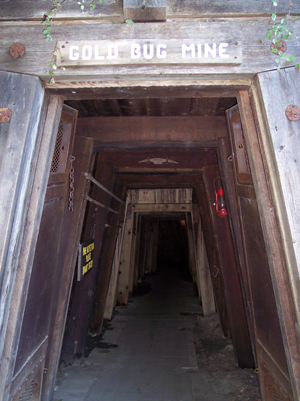 The Gold Bug Mine (originally the Hattie Mine) is a typical hard rock mine found in the Mother Lode. If you haven’t had the opportunity to safely explore an underground mine, or want to introduce your kids to a little fun and history, Gold Bug Park is ideal. Not only can you can go underground, but you can visit a stamp mill and blacksmith shop, have a picnic, and do a little hiking, too. When you buy your tour ticket, you’ll get a hard hat to wear and a hand-held audio wand. As you make your way through the mine, the voice of an old-timer tells the tales of the Gold Bug and the California Gold Rush. Article continued here... Wednesday, October 05 2011
Did you see the article we wrote for the Sept/Oct 2011 issue of Gold Prospectors magazine about Idaho's Silver Valley? If you're a member and get the magazine, check out pages 20-26. The Silver Valley is packed with fun family activities such as underground mine tours, mining museums, and you can also camp, hike, bike ride, ski, hunt for star garnets, prospect, and even visit the oldest standing building in the state of Idaho— the Sacred Heart Mission located in nearby Cataldo. If you're not a member of GPAA and don't get the magazine, download a .pdf of the article here to learn more about the Silver Valley's 120 years of mining history. Monday, May 03 2010
To learn about gold mining of yesteryear, take your family on a tour of the authentic Crystal Gold Mine in Kellogg, Idaho. Dress warmly, don a bright yellow hard hat, grab a flashlight, and follow your tour guide into the underground world of gold mining. For over 100 years, no one knew this mine existed. The original prospector simply disappeared, leaving his mine car, track, tools, and high-grade gold ore behind—sure signs he intended to come back, but strangely never did. During the years that the mine was lost and undisturbed, beautiful turquoise-colored smithsonite crystals formed on the walls. You’ll also see gold and wire silver, too. After the tour, pan for gold outdoors under the tutelage of your mine guide. Even if there’s no flash in your pan, you might find a star garnet—Idaho’s state stone. And what a rare souvenir that would be; these garnets naturally occur in only two places on earth—India and Idaho. Wednesday, April 21 2010
Last year, more than 285 million people visited national parks and other units of the National Park System, marking 2009 the fifth busiest year ever. For those who like statistics, that means 10 million more Americans and foreign tourists visited national parks than the year before— a 3.9% increase. The all-time visitation record of 287.2 million was set in 1987. In 2010, the National Park Service is once again offering fee-free days, allowing visitors to check out the nation’s 392 national parks without paying an admission fee that usually ranges from $3 to $25, depending on the park. The fee waiver includes entrance fees, commercial tour fees, and transportation entrance fees. Other costs such as reservations, camping, concessions, and fees collected by third parties are not waived. The first fee-free period this year is actually an entire week—National Parks Week, April 17-25. Although you cannot use your metal detector in a national park, take your detector along on your trip because there are plenty of public lands, parks, etc. to explore while you're traveling. The Top 10 most visited national parks are:
|
|
Nugget of News Blog |






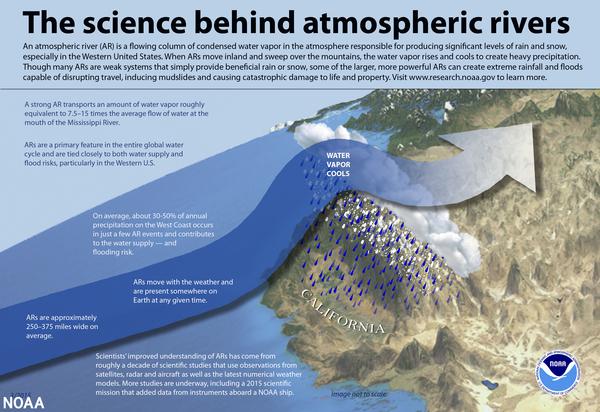 Atmospheric rivers are large, narrow sections of the earth's atmosphere that carry moisture from the earth's tropics near the equator to the poles. On average, the earth has four to five active atmospheric rivers at any time. A vast majority of atmospheric rivers happen in the fall and winter. The northern Pacific Coast receives the bulk of activity in the fall, and the California coast receives more in the winter. Since December 2022, the U.S. West has been slammed with back-to-back-to-back atmospheric rivers. These events provide as much as half of the region’s annual precipitation, bringing much-needed water to parched lands and adding to the snowpack in the high mountains. This year’s storms have done a lot to restore the landscape drought and is “greening up” the landscape and refilling many smaller reservoirs.
Atmospheric rivers are large, narrow sections of the earth's atmosphere that carry moisture from the earth's tropics near the equator to the poles. On average, the earth has four to five active atmospheric rivers at any time. A vast majority of atmospheric rivers happen in the fall and winter. The northern Pacific Coast receives the bulk of activity in the fall, and the California coast receives more in the winter. Since December 2022, the U.S. West has been slammed with back-to-back-to-back atmospheric rivers. These events provide as much as half of the region’s annual precipitation, bringing much-needed water to parched lands and adding to the snowpack in the high mountains. This year’s storms have done a lot to restore the landscape drought and is “greening up” the landscape and refilling many smaller reservoirs.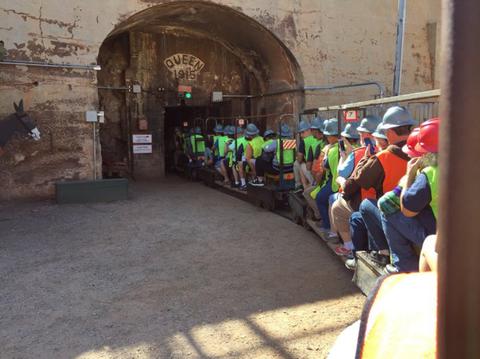 miners. To do exactly that and learn how copper and other ore was first mined in Bisbee, Arizona, take the underground Queen Mine tour. Outfitted with hard hat, miner’s headlamp and a neon vest, visitors ride 1,500 feet into the mine and learn about equipment, techniques, dangers and a century worth of history. Tour guides are actual retired miners, so you know you’ll get the real highlights of working underground. You’ll learn about blasting with dynamite, the role of mules, and even how miners went to the bathroom while working in the mines!
miners. To do exactly that and learn how copper and other ore was first mined in Bisbee, Arizona, take the underground Queen Mine tour. Outfitted with hard hat, miner’s headlamp and a neon vest, visitors ride 1,500 feet into the mine and learn about equipment, techniques, dangers and a century worth of history. Tour guides are actual retired miners, so you know you’ll get the real highlights of working underground. You’ll learn about blasting with dynamite, the role of mules, and even how miners went to the bathroom while working in the mines!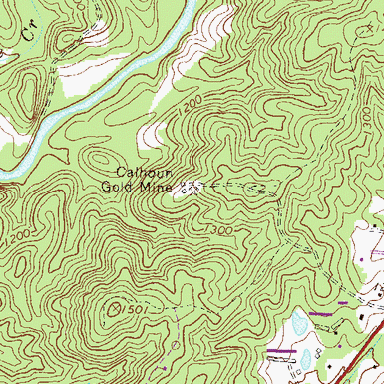 urn out to be quite so secret any more.
urn out to be quite so secret any more. as determined to find the source. For months, the Georgia native followed North Clear Creek upstream from the present-day city of Golden, and on May 6, 1859, made the first lode discovery in the Rockies! Gregory sold his two claims for $21,000 a few months later and left the area, but his name carries on. “Gregory Gulch” is located between the towns of Central City and Black Hawk. The Gregory Mining District encompasses these towns plus several other mining camps, and as a whole, this area is referred to as "The Richest Square Mile On Earth.” Central City takes it name from being “central” to all the mining activity.
as determined to find the source. For months, the Georgia native followed North Clear Creek upstream from the present-day city of Golden, and on May 6, 1859, made the first lode discovery in the Rockies! Gregory sold his two claims for $21,000 a few months later and left the area, but his name carries on. “Gregory Gulch” is located between the towns of Central City and Black Hawk. The Gregory Mining District encompasses these towns plus several other mining camps, and as a whole, this area is referred to as "The Richest Square Mile On Earth.” Central City takes it name from being “central” to all the mining activity. One of the most notable buildings in downtown is the 150-room Teller House Hotel. Located on the corner of Eureka and Pine Streets, it was built in 1872 at a cost of $87,000, plus another $20,000 to furnish. From its non-descript exterior, you’d never believe that the Teller House was once considered to be the most elegant hotel between Chicago and San Francisco. Financed largely by Henry Teller, who became the first senator from Colorado and later, Secretary of the Interior, it’s no longer used as a hotel but is the center for opera-related activities (Central City Opera House is next door).
One of the most notable buildings in downtown is the 150-room Teller House Hotel. Located on the corner of Eureka and Pine Streets, it was built in 1872 at a cost of $87,000, plus another $20,000 to furnish. From its non-descript exterior, you’d never believe that the Teller House was once considered to be the most elegant hotel between Chicago and San Francisco. Financed largely by Henry Teller, who became the first senator from Colorado and later, Secretary of the Interior, it’s no longer used as a hotel but is the center for opera-related activities (Central City Opera House is next door).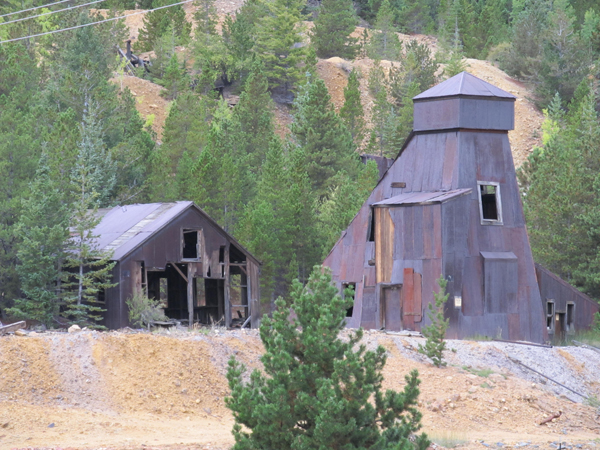 Known for their excellent stonework, the rock retaining walls visible in various places along the route were built by a very large population of Cornish miners. The walls were part of the former Gilpin Tramway, a 26-mile narrow gauge railroad that once looped around the gulches and through the surrounding communities. Sidings went to many of the major mines. Most of the retaining walls don’t use mortar, and were instead constructed using a dry-stack method. After more than a century, most of the rockwork is still holding up— no maintenance required.
Known for their excellent stonework, the rock retaining walls visible in various places along the route were built by a very large population of Cornish miners. The walls were part of the former Gilpin Tramway, a 26-mile narrow gauge railroad that once looped around the gulches and through the surrounding communities. Sidings went to many of the major mines. Most of the retaining walls don’t use mortar, and were instead constructed using a dry-stack method. After more than a century, most of the rockwork is still holding up— no maintenance required.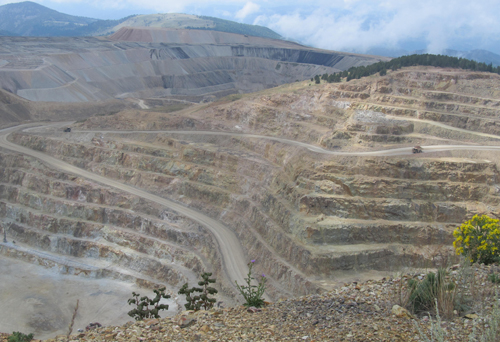 A few miles outside of Victor, you’ll find an impressive view of the Cripple Creek and Victor Mining District from atop the American Eagles Scenic Overlook. Stop at the Victor visitor center first (formerly a train depot) for a map. From an elevation of 10,570 feet, you get a bird’s eye look down into the CC&V surface operations where massive 240-ton haul trucks riding on 12-foot diameter tires haul ore up and down a abyrinth of roads. Mount Pisgah and the Sangre de Cristo and Collegiate Mountains make a nice backdrop.
A few miles outside of Victor, you’ll find an impressive view of the Cripple Creek and Victor Mining District from atop the American Eagles Scenic Overlook. Stop at the Victor visitor center first (formerly a train depot) for a map. From an elevation of 10,570 feet, you get a bird’s eye look down into the CC&V surface operations where massive 240-ton haul trucks riding on 12-foot diameter tires haul ore up and down a abyrinth of roads. Mount Pisgah and the Sangre de Cristo and Collegiate Mountains make a nice backdrop. 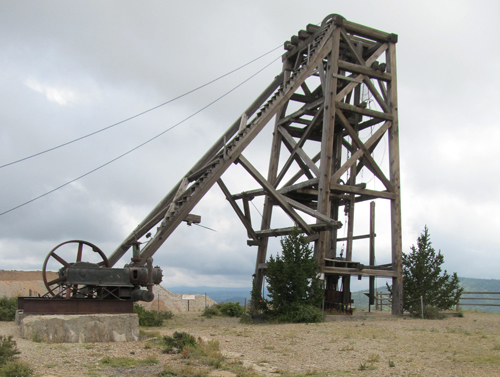 The original American Eagles headframe is still standing proudly, and the double-drum hoist is still in its place, too. The shaft, however, has been sealed. Remnants of a blacksmith shop and mine superintendent’s house are also at the overlook. Interpretive signs around the site tell the story of Winfield Stratton who purchased the American Eagles in 1895 after a huge success with his local Independence Mine. In fact, Mr. Stratton was Victor’s first millionaire and sold the Independence Mine for $11 million. The American Eagles was worked until 1940, but unfortunately little is known about its actual production since it was a private claim.
The original American Eagles headframe is still standing proudly, and the double-drum hoist is still in its place, too. The shaft, however, has been sealed. Remnants of a blacksmith shop and mine superintendent’s house are also at the overlook. Interpretive signs around the site tell the story of Winfield Stratton who purchased the American Eagles in 1895 after a huge success with his local Independence Mine. In fact, Mr. Stratton was Victor’s first millionaire and sold the Independence Mine for $11 million. The American Eagles was worked until 1940, but unfortunately little is known about its actual production since it was a private claim. The Independence Town Site is an interesting stop. The steel headframe of the Vindicator Mine is hard to miss, and a gravel path takes you past what’s left of a surface plant, ore processing facility, and a residence that has definitely seen better days. Independence originated as Hull’s Camp on the Hull City placer claim. Although some placer gold was found, the real riches came from underground veins, so there were several different mines here. The Vindicator is credited with producing a total of 1,244,000 troy ounces of gold between 1895 and 1953. Also nearby is what remains of the Theresa Mine, which produced over 120,000 troy ounces between 1895 and 1961.
The Independence Town Site is an interesting stop. The steel headframe of the Vindicator Mine is hard to miss, and a gravel path takes you past what’s left of a surface plant, ore processing facility, and a residence that has definitely seen better days. Independence originated as Hull’s Camp on the Hull City placer claim. Although some placer gold was found, the real riches came from underground veins, so there were several different mines here. The Vindicator is credited with producing a total of 1,244,000 troy ounces of gold between 1895 and 1953. Also nearby is what remains of the Theresa Mine, which produced over 120,000 troy ounces between 1895 and 1961.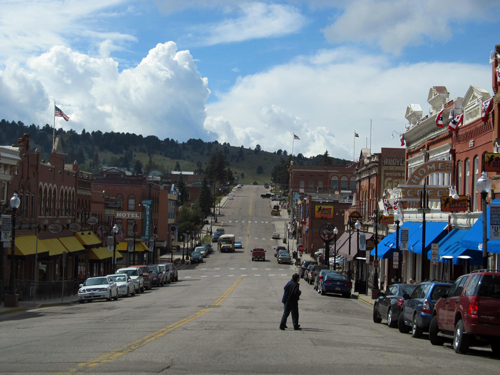 The gold rush not only brought prospectors into the quiet ranch town of Cripple Creek, but it brought in goods and services needed by those miners. Lumber yards, hotels, 100 saloons, 91 lawyers, 80 doctors, 40 assay offices, 14 newspapers, three railroads, two electric streetcar systems, and a trolley turned a small town into a booming gold camp of over 50,000. Interestingly enough, Cripple Creek was also the site of some of the worst mining labor conflicts in American history, culminating in the state militia being called in in 1903. Several celebrities also spent time here, including comedian and film star Groucho Marx, lawman and gambler Wyatt Earp, and boxer Jack Dempsey. Unfortunately, two accidental fires burned much of the city in 1896. Wisely, however, the city fathers declared that the business district be rebuilt in brick, and so many of those rebuilt buildings are still standing.
The gold rush not only brought prospectors into the quiet ranch town of Cripple Creek, but it brought in goods and services needed by those miners. Lumber yards, hotels, 100 saloons, 91 lawyers, 80 doctors, 40 assay offices, 14 newspapers, three railroads, two electric streetcar systems, and a trolley turned a small town into a booming gold camp of over 50,000. Interestingly enough, Cripple Creek was also the site of some of the worst mining labor conflicts in American history, culminating in the state militia being called in in 1903. Several celebrities also spent time here, including comedian and film star Groucho Marx, lawman and gambler Wyatt Earp, and boxer Jack Dempsey. Unfortunately, two accidental fires burned much of the city in 1896. Wisely, however, the city fathers declared that the business district be rebuilt in brick, and so many of those rebuilt buildings are still standing. 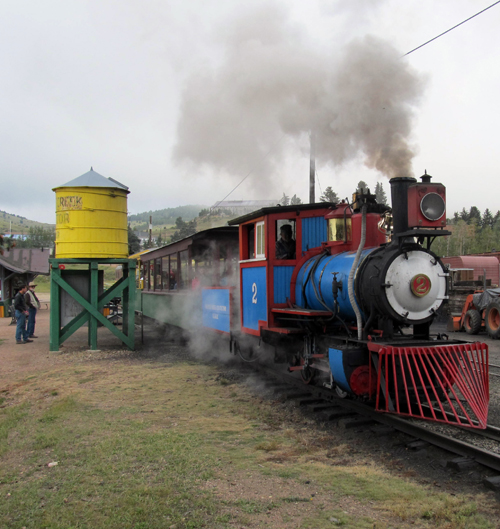 A four-mile narrated ride on the Cripple Creek & Victor Narrow Gauge Railroad passes several historical sites that can only be seen from the rails. The train is pulled by a coal-fired steam locomotive that looks a bit like Thomas the Tank Engine thanks to the baby blue paint. You can also see what it would have been like to be part of the criminal element in the early 1900s by visiting the Cripple Creek Jail Museum. It is housed in the red brick building that served as the Teller County jail from 1902 until the 1990s. The original cells are there, along with displays that highlight the laws and lawlessness of the 1890s.
A four-mile narrated ride on the Cripple Creek & Victor Narrow Gauge Railroad passes several historical sites that can only be seen from the rails. The train is pulled by a coal-fired steam locomotive that looks a bit like Thomas the Tank Engine thanks to the baby blue paint. You can also see what it would have been like to be part of the criminal element in the early 1900s by visiting the Cripple Creek Jail Museum. It is housed in the red brick building that served as the Teller County jail from 1902 until the 1990s. The original cells are there, along with displays that highlight the laws and lawlessness of the 1890s.  On Highway 67 between the towns of Cripple Creek and Victor, you will cross the highest bridge on the Colorado State Highway system. The bridge across Arequa Gulch was built in 2000-2001 for $418 million by the CC&V to accommodate their expansion. The 1,218 foot long bridge is over 250 feet tall at its highest point. The road is currently being rerouted again due to more growth. Near the bridge is CC&V’s leach facility and gold ore processing plant. The Valley Leach Facility (VLF) is where the gold is recovered from the ore by leaching with a sodium cyanide process solution. You can’t miss what looks like giant rock piles. The VLF actually functions like a big bathtub filled with crushed ore. The solution is applied to the ore using a drip irrigation system. The sodium cyanide process solution dissolves the gold and silver on the surface of the rock. The “bathtub” has a triple thick liner and a state-of-the-art monitoring and detection system to ensure zero discharge. The gold-bearing solution (called "pregnant solution”) is captured at the bottom of the liners. Gold is then recovered from the pregnant solution with a carbon absorption process. North of the VLF is the crushing facility that can process approximately 50 tons of ore per minute. Trucks load up the pulverized ore and delivery it to the VLF. This process recovers a whopping 200,000 ounces of gold annually. Eureka!
On Highway 67 between the towns of Cripple Creek and Victor, you will cross the highest bridge on the Colorado State Highway system. The bridge across Arequa Gulch was built in 2000-2001 for $418 million by the CC&V to accommodate their expansion. The 1,218 foot long bridge is over 250 feet tall at its highest point. The road is currently being rerouted again due to more growth. Near the bridge is CC&V’s leach facility and gold ore processing plant. The Valley Leach Facility (VLF) is where the gold is recovered from the ore by leaching with a sodium cyanide process solution. You can’t miss what looks like giant rock piles. The VLF actually functions like a big bathtub filled with crushed ore. The solution is applied to the ore using a drip irrigation system. The sodium cyanide process solution dissolves the gold and silver on the surface of the rock. The “bathtub” has a triple thick liner and a state-of-the-art monitoring and detection system to ensure zero discharge. The gold-bearing solution (called "pregnant solution”) is captured at the bottom of the liners. Gold is then recovered from the pregnant solution with a carbon absorption process. North of the VLF is the crushing facility that can process approximately 50 tons of ore per minute. Trucks load up the pulverized ore and delivery it to the VLF. This process recovers a whopping 200,000 ounces of gold annually. Eureka!